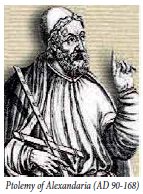Mathematics - Trigonometry: Introduction | 11th Mathematics : UNIT 3 : Trigonometry
Chapter: 11th Mathematics : UNIT 3 : Trigonometry
Trigonometry: Introduction
Introduction
Trigonometry is primarily a
branch of Mathematics that studies relationship involving sides and angles of
triangles. The word trigonometry stems from the Greek word trigonon which means triangle and metron which means to measure. So,
literally trigonometry is the study of measuring triangles. Greek
mathematicians used trigonometric ratios to determine unknown distances. The
Egyptians on the other hand used a primitive form of trigonometry for building
Pyramids in second millinium BCE. Aristarchus (310-250 BCE) used trigonometry
to determine the distances of Moon and Sun.

Eratosthenes (276-195 BCE) was
the first person to calculate the earthŌĆÖs circumference, which he did by
applying a measuring system using stadia, a standard unit of measurement during that period. The general
principles of Trigonometry were formulated by the Greek astronomer Hipparchus
(190-120 BCE) and he is credited as the founder of trigonometry. His ideas were
used by Ptolemy of Alexandria (CE 100-170) leading to the development of
Ptolemy theory of Astronomy. The most significant development of Trigonometry
in ancient times was in India. Indian Mathematician and Astronomer Aryabhata
(CE 476-550) defined sine, cosine, versine (1ŌłÆcosine), inverse sine and he gave
mathematical results in the form of 108 verses which included a formula for the
area of a triangle. Mathematicians Brahmagupta (598 CE), Bhaskara I (600 CE)
and Bhaskara II (1114 CE) are other Ancient Indians who contributed
significantly to develop Trigonometry. Trigonometry was developed as a separate
branch of Mathematics through the works of Johann Bernoulli (1667-1748) and
Leonhard Euler (1707-1783). Euler established the fundamental results
connecting trigonometric functions and complex exponential. Joseph Fourier
(1768-1830) made important contribution to the study of trigonometric series.
His invention of Fourier series has a wide range of applications especially in
vibration analysis, electrical engineering, acoustics, optics, signal
processing, image processing and quantum mechanics. In modern times,
trigonometric functions are developed as mathematical functions of angular
magnitudes, through the medium of which many kinds of geometrical and algebraic
investigations are carried out in every branch of Mathematics and applications.
Our GPS system in cars and mobile phones is based on trigonometric
calculations. Advanced medical scanning procedures such as CT and MRI, used in
detecting tumors, involve sine and cosine functions.
Let us recapture the basics of
trigonometric ratios using acute angles and their properties, which were
discussed in earlier classes.
Related Topics